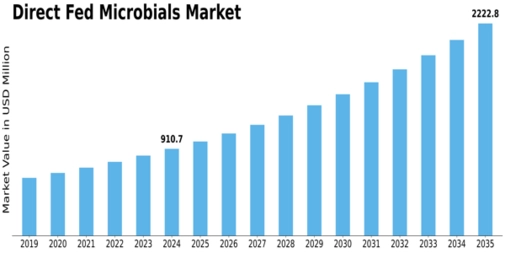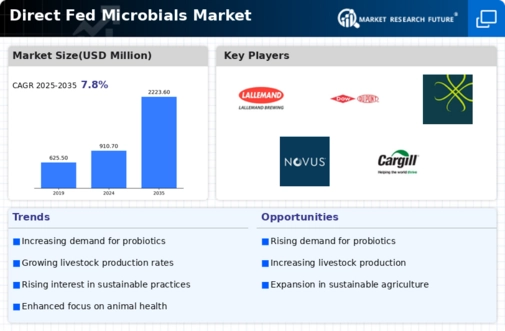-
Executive Summary
-
Scope of the Report
-
Market Definition
-
Scope of the Study
- Research Objectives
- Assumptions & Limitations
-
Market Structure
-
Market Research Methodology
-
Research Process
-
Secondary Research
-
Primary Research
-
Forecast Model
-
Market Landscape
-
Supply Chain Analysis
- Raw Material Suppliers
- Manufacturers/Producers
- Distributors/Retailers/Wholesalers/E-Commerce
- End Users
-
Porter’s Five Forces Analysis
- Threat of New Entrants
- Bargaining Power of Buyers
- Bargaining Power of Suppliers
- Threat of Substitutes
- Internal Rivalry
-
Market Dynamics of the Global Direct Fed Microbials Market
-
Introduction
-
Drivers
-
Restraints
-
Opportunities
-
Challenges
-
Global Direct Fed Microbials Market, by Type
-
Introduction
-
Lactic Acid Bacteria
- Market Estimates & Forecast, 2022–2030
- Market Estimates & Forecast, by Region, 2022–2030
-
Bacillus subtilis
- Market Estimates & Forecast, 2022–2030
- Market Estimates & Forecast, by Region, 2022–2030
-
Yeast
- Market Estimates & Forecast, 2022–2030
- Market Estimates & Forecast, by Region, 2022–2030
-
Others
- Market Estimates & Forecast, 2022–2030
- Market Estimates & Forecast, by Region, 2022–2030
-
Global Direct Fed Microbials Market, by Livestock
-
Introduction
-
Ruminants
- Market Estimates & Forecast, 2022–2030
- Market Estimates & Forecast, by Region, 2022–2030
-
Poultry
- Market Estimates & Forecast, 2022–2030
- Market Estimates & Forecast, by Region, 2022–2030
-
Swine
- Market Estimates & Forecast, 2022–2030
- Market Estimates & Forecast, by Region, 2022–2030
-
Others
- Market Estimates & Forecast, 2022–2030
- Market Estimates & Forecast, by Region, 2022–2030
-
Global Direct Fed Microbials Market, by Form
-
Introduction
-
Dry
- Market Estimates & Forecast, 2022–2030
- Market Estimates & Forecast, by Region, 2022–2030
-
Liquid
- Market Estimates & Forecast, 2022–2030
- Market Estimates & Forecast, by Region, 2022–2030
-
Global Direct Fed Microbials Market, by Region
-
Introduction
-
North America
- Market Estimates & Forecast, 2022–2030
- Market Estimates & Forecast, by Type, 2022–2030
- Market Estimates & Forecast, by Livestock, 2022–2030
- Market Estimates & Forecast, by Form, 2022–2030
- Market Estimates & Forecast, by Country, 2022–2030
- US
- Canada
- Mexico
-
Europe
- Market Estimates & Forecast, 2022–2030
- Market Estimates & Forecast, by Type, 2022–2030
- Market Estimates & Forecast, by Livestock, 2022–2030
- Market Estimates & Forecast, by Form, 2022–2030
- Market Estimates & Forecast, by Country, 2022–2030
- Germany
- France
- Italy
- Spain
- UK
- Rest of Europe
-
Asia-Pacific
- Market Estimates & Forecast, 2022–2030
- Market Estimates & Forecast, by Type, 2022–2030
- Market Estimates & Forecast, by Livestock, 2022–2030
- Market Estimates & Forecast, by Form, 2022–2030
- Market Estimates & Forecast, by Country, 2022–2030
- China
- India
- Japan
- Australia & New Zealand
- Rest of Asia-Pacific
-
Rest of the World (RoW)
- Market Estimates & Forecast, 2022–2030
- Market Estimates & Forecast, by Type, 2022–2030
- Market Estimates & Forecast, by Livestock, 2022–2030
- Market Estimates & Forecast, by Form, 2022–2030
- Market Estimates & Forecast, by Country, 2022–2030
- South America
- Middle East
- Africa
-
Company Landscape
-
Introduction
-
Market Key Strategies
-
Key Development Analysis
-
(Expansions/Mergers and Acquisitions/Joint Ventures/Product Developments/Agreements/Investments)
-
Company Profiles
-
Archer Daniels Midland Company
- Company Overview
- Financial Updates
- Product/Business Segment Overview
- Key Strategies
- Key Developments
- SWOT Analysis
-
DowDuPont
- Company Overview
- Financial Updates
- Product/Business Segment Overview
- Key Strategies
- Key Developments
- SWOT Analysis
-
Novozymes
- Company Overview
- Financial Updates
- Product/Business Segment Overview
- Key Strategies
- Key Developments
- SWOT Analysis
-
DSM N.V.
- Company Overview
- Financial Updates
- Product/Business Segment Overview
- Key Strategies
- Key Developments
- SWOT Analysis
-
Lallemand Inc.
- Company Overview
- Financial Updates
- Product/Business Segment Overview
- Key Strategies
- Key Developments
- SWOT Analysis
-
Chr. Hansen Holding A/S
- Company Overview
- Financial Updates
- Product/Business Segment Overview
- Key Strategies
- Key Developments
- SWOT Analysis
-
Novus International, Inc.
- Company Overview
- Financial Updates
- Product/Business Segment Overview
- Key Strategies
- Key Developments
- SWOT Analysis
-
Biomin Holding GmbH
- Company Overview
- Financial Updates
- Product/Business Segment Overview
- Key Strategies
- Key Developments
- SWOT Analysis
-
Kemin Industries, Inc
- Company Overview
- Financial Updates
- Product/Business Segment Overview
- Key Strategies
- Key Developments
- SWOT Analysis
-
Cargill Inc.
- Company Overview
- Financial Updates
- Product/Business Segment Overview
- Key Strategies
- Key Developments
- SWOT Analysis
-
Bio-Vet
- Company Overview
- Financial Updates
- Product/Business Segment Overview
- Key Strategies
- Key Developments
- SWOT Analysis
-
Alltech Inc.
- Company Overview
- Financial Updates
- Product/Business Segment Overview
- Key Strategies
- Key Developments
- SWOT Analysis
-
American Biosystems, Inc.
- Company Overview
- Financial Updates
- Product/Business Segment Overview
- Key Strategies
- Key Developments
- SWOT Analysis
-
The Fertrell Company
- Company Overview
- Financial Updates
- Product/Business Segment Overview
- Key Strategies
- Key Developments
- SWOT Analysis
-
Micron Bio-Systems
- Company Overview
- Financial Updates
- Product/Business Segment Overview
- Key Strategies
- Key Developments
- SWOT Analysis
-
Conclusion
-
LIST OF TABLES
-
Global Direct Fed Microbials Market, by Region, 2022–2030 (USD Million)
-
Global Direct Fed Microbials Market, by Type, 2022–2030 (USD Million)
-
Global Direct Fed Microbials Market, by Livestock, 2022–2030 (USD Million)
-
Global Direct Fed Microbials Market, by Form, 2022–2030 (USD Million)
-
North America: Direct Fed Microbials Market, by Country, 2022–2030 (USD Million)
-
North America: Direct Fed Microbials Market, by Type, 2022–2030 (USD Million)
-
North America: Direct Fed Microbials Market, by Livestock, 2022–2030 (USD Million)
-
North America: Direct Fed Microbials Market, by Form, 2022–2030 (USD Million)
-
US: Direct Fed Microbials Market, by Type, 2022–2030 (USD Million)
-
US: Direct Fed Microbials Market, by Livestock, 2022–2030 (USD Million)
-
US: Direct Fed Microbials Market, by Form, 2022–2030 (USD Million)
-
Canada: Direct Fed Microbials Market, by Type, 2022–2030 (USD Million)
-
Canada: Direct Fed Microbials Market, by Livestock, 2022–2030 (USD Million)
-
Canada: Direct Fed Microbials Market, by Form, 2022–2030 (USD Million)
-
Mexico: Direct Fed Microbials Market, by Type, 2022–2030 (USD Million)
-
Mexico: Direct Fed Microbials Market, by Livestock, 2022–2030 (USD Million)
-
Mexico: Direct Fed Microbials Market, by Form, 2022–2030 (USD Million)
-
Europe: Direct Fed Microbials Market, by Country, 2022–2030 (USD Million)
-
Europe: Direct Fed Microbials Market, by Type, 2022–2030 (USD Million)
-
Europe: Direct Fed Microbials Market, by Livestock, 2022–2030 (USD Million)
-
Europe: Direct Fed Microbials Market, by Form, 2022–2030 (USD Million)
-
Germany: Direct Fed Microbials Market, by Type, 2022–2030 (USD Million)
-
Germany: Direct Fed Microbials Market, by Livestock, 2022–2030 (USD Million)
-
Germany: Direct Fed Microbials Market, by Form, 2022–2030 (USD Million)
-
France: Direct Fed Microbials Market, by Type, 2022–2030 (USD Million)
-
France: Direct Fed Microbials Market, by Livestock, 2022–2030 (USD Million)
-
France: Direct Fed Microbials Market, by Form, 2022–2030 (USD Million)
-
Italy: Direct Fed Microbials Market, by Type, 2022–2030 (USD Million)
-
Italy: Direct Fed Microbials Market, by Livestock, 2022–2030 (USD Million)
-
Italy: Direct Fed Microbials Market, by Form, 2022–2030 (USD Million)
-
Spain: Direct Fed Microbials Market, by Type, 2022–2030 (USD Million)
-
Spain: Direct Fed Microbials Market, by Livestock, 2022–2030 (USD Million)
-
Spain: Direct Fed Microbials Market, by Form, 2022–2030 (USD Million)
-
UK: Direct Fed Microbials Market, by Type, 2022–2030 (USD Million)
-
UK: Direct Fed Microbials Market, by Livestock, 2022–2030 (USD Million)
-
UK: Direct Fed Microbials Market, by Form, 2022–2030 (USD Million)
-
Rest of Europe: Direct Fed Microbials Market, by Type, 2022–2030 (USD Million)
-
Rest of Europe: Direct Fed Microbials Market, by Livestock, 2022–2030 (USD Million)
-
Rest of Europe: Direct Fed Microbials Market, by Form, 2022–2030 (USD Million)
-
Asia-Pacific: Direct Fed Microbials Market, by Country, 2022–2030 (USD Million)
-
Asia-Pacific: Direct Fed Microbials Market, by Type, 2022–2030 (USD Million)
-
Asia-Pacific: Direct Fed Microbials Market, by Livestock, 2022–2030 (USD Million)
-
Asia-Pacific: Direct Fed Microbials Market, by Form, 2022–2030 (USD Million)
-
China: Direct Fed Microbials Market, by Type, 2022–2030 (USD Million)
-
China: Direct Fed Microbials Market, by Livestock, 2022–2030 (USD Million)
-
China: Direct Fed Microbials Market, by Form, 2022–2030 (USD Million)
-
India: Direct Fed Microbials Market, by Type, 2022–2030 (USD Million)
-
India: Direct Fed Microbials Market, by Livestock, 2022–2030 (USD Million)
-
India: Direct Fed Microbials Market, by Form, 2022–2030 (USD Million)
-
Japan: Direct Fed Microbials Market, by Type, 2022–2030 (USD Million)
-
Japan: Direct Fed Microbials Market, by Livestock, 2022–2030 (USD Million)
-
Japan: Direct Fed Microbials Market, by Form, 2022–2030 (USD Million)
-
Rest of Asia-Pacific: Direct Fed Microbials Market, by Type, 2022–2030 (USD Million)
-
Rest of Asia-Pacific: Direct Fed Microbials Market, by Livestock, 2022–2030 (USD Million)
-
Rest of Asia-Pacific: Direct Fed Microbials Market, by Form, 2022–2030 (USD Million)
-
Rest of the World (RoW): Direct Fed Microbials Market, by Country, 2022–2030 (USD Million)
-
Rest of the World (RoW): Direct Fed Microbials Market, by Type, 2022–2030 (USD Million)
-
Rest of the World (RoW): Direct Fed Microbials Market, by Livestock, 2022–2030 (USD Million)
-
Rest of the World (RoW): Direct Fed Microbials Market, by Form, 2022–2030 (USD Million)
-
South America: Direct Fed Microbials Market, by Type, 2022–2030 (USD Million)
-
South America: Direct Fed Microbials Market, by Livestock, 2022–2030 (USD Million)
-
South America: Direct Fed Microbials Market, by Form, 2022–2030 (USD Million)
-
Middle East: Direct Fed Microbials Market, by Type, 2022–2030 (USD Million)
-
Middle East: Direct Fed Microbials Market, by Livestock, 2022–2030 (USD Million)
-
Middle East: Direct Fed Microbials Market, by Form, 2022–2030 (USD Million)
-
Africa: Direct Fed Microbials Market, by Type, 2022–2030 (USD Million)
-
Africa: Direct Fed Microbials Market, by Livestock, 2022–2030 (USD Million)
-
Africa: Direct Fed Microbials Market, by Form, 2022–2030 (USD Million)
-
LIST OF FIGURES
-
Global Direct Fed Microbials Market Segmentation
-
Forecast Research Methodology
-
Porter’s Five Forces Analysis of the Global Direct Fed Microbials Market
-
Value Chain of the Global Direct Fed Microbials Market
-
Share of the Global Direct Fed Microbials Market in 2022, by Country (%)
-
Global Direct Fed Microbials Market, by Region, 2022–2030,
-
Global Direct Fed Microbials Market Size, by Type, 2022
-
Share of the Global Direct Fed Microbials Market, by Type, 2022–2030 (%)
-
Global Direct Fed Microbials Market Size, by Livestock, 2022
-
Share of the Global Direct Fed Microbials Market, by Livestock, 2022–2030 (%)
-
Global Direct Fed Microbials Market Size, by Form, 2022
-
Share of the Global Direct Fed Microbials Market, by Form, 2022–2030 (%)

















Leave a Comment